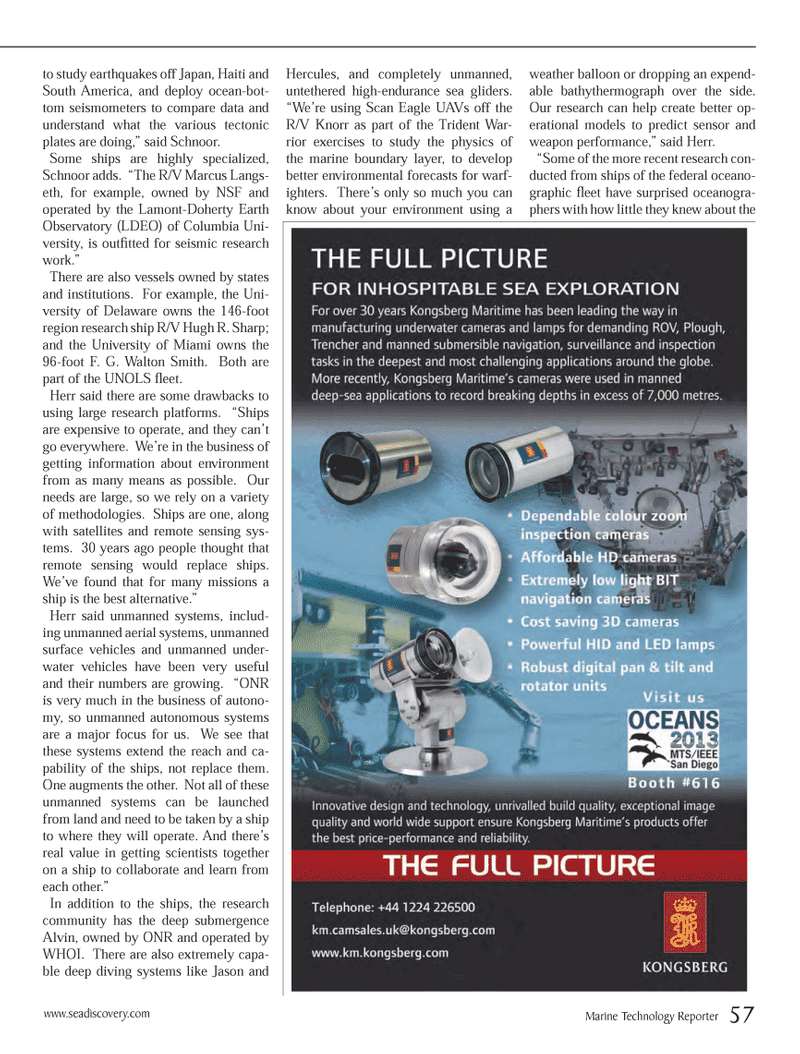
Page 57: of Marine Technology Magazine (September 2013)
Ocean Observation: Gliders, Buoys & Sub-Surface monitoring Networks
Read this page in Pdf, Flash or Html5 edition of September 2013 Marine Technology Magazine
to study earthquakes off Japan, Haiti and South America, and deploy ocean-bot- tom seismometers to compare data and understand what the various tectonic plates are doing,? said Schnoor. Some ships are highly specialized, Schnoor adds. ?The R/V Marcus Langs-eth, for example, owned by NSF and operated by the Lamont-Doherty Earth Observatory (LDEO) of Columbia Uni- versity, is out tted for seismic research work.? There are also vessels owned by states and institutions. For example, the Uni- versity of Delaware owns the 146-foot region research ship R/V Hugh R. Sharp; and the University of Miami owns the 96-foot F. G. Walton Smith. Both are part of the UNOLS eet.Herr said there are some drawbacks to using large research platforms. ?Ships are expensive to operate, and they can?t go everywhere. We?re in the business of getting information about environment from as many means as possible. Our needs are large, so we rely on a variety of methodologies. Ships are one, along with satellites and remote sensing sys-tems. 30 years ago people thought that remote sensing would replace ships. We?ve found that for many missions a ship is the best alternative.? Herr said unmanned systems, includ-ing unmanned aerial systems, unmanned surface vehicles and unmanned under- water vehicles have been very useful and their numbers are growing. ?ONR is very much in the business of autono- my, so unmanned autonomous systems are a major focus for us. We see that these systems extend the reach and ca- pability of the ships, not replace them. One augments the other. Not all of these unmanned systems can be launched from land and need to be taken by a ship to where they will operate. And there?s real value in getting scientists together on a ship to collaborate and learn from each other.? In addition to the ships, the research community has the deep submergence Alvin, owned by ONR and operated by WHOI. There are also extremely capa- ble deep diving systems like Jason and Hercules, and completely unmanned, untethered high-endurance sea gliders. ?We?re using Scan Eagle UAVs off the R/V Knorr as part of the Trident War- rior exercises to study the physics of the marine boundary layer, to develop better environmental forecasts for warf- ighters. There?s only so much you can know about your environment using a weather balloon or dropping an expend- able bathythermograph over the side. Our research can help create better op-erational models to predict sensor and weapon performance,? said Herr. ?Some of the more recent research con-ducted from ships of the federal oceano-graphic eet have surprised oceanogra- phers with how little they knew about the www.seadiscovery.com Marine Technology Reporter 57MTR #7 (50-65).indd 57MTR #7 (50-65).indd 578/22/2013 11:46:37 AM8/22/2013 11:46:37 AM

 56
56

 58
58
